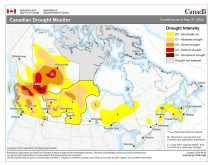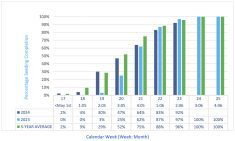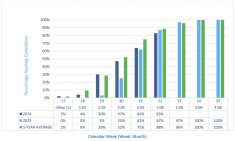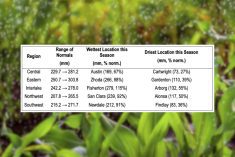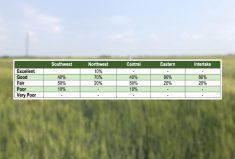Fall rye stands are at the soft dough stage. Rapid advancement in winter cereal crop development continues and crop conditions are rated as good. Spring cereals continue to advance with earliest planted fields having moved into the flag leaf/head emergence stage. Soybean and dry bean crops are progressing at a slower pace given the cooler conditions. Growth staging for both crops reported at first to third trifoliate stage. Weed control has been acceptable in these crops. Field peas are at the eight to ten node stage.
Cereals
Fall rye/winter wheat stands are at the milk to soft dough stage, with fungicide applications for fusarium head blight complete. Rapid winter cereal crop development continued to be noted with crop conditions being good.
Read Also

Still hard to predict precise fertilizer payback
Despite decades of advances, international research finds no clear answer for where and when adding nutrient will fail to boost growth.
Oats/spring wheat are at four leaves to stem elongation. Early seeded spring cereals have moved into flag leaf/head emergence stage.
Grain corn growth stage ranges from V4 to V6.
Oilseeds
Canola growth stage ranges from the rosette to flowering stage.
Growth stages ranging from cotyledon to rosette/cabbaging have been reported in the Interlake and Eastern regions.
Sunflowers are at the V8 to V12 growth stage. Flax crops ranged from growth stage 4 to 5.
Pulses and Soybeans
Field peas are at the eight to ten node stage, with some fungicide application occurring in the Southwest region.
Soybean growth stage ranges from first to third trifoliate. Overall crop development is delayed with producers looking for warmer conditions to drive the crop forward.
Iron deficiency chlorosis continues to show up in some fields.
Dry beans are in first to second trifoliate stage.
Forages and Livestock
Forages
Grass and forages are growing well and would benefit from warmer weather to make the most of the moisture. Bromes and ryegrasses are heading, and alfalfa is mid flowering. Grasses have headed out, except for big blue stem and little blue stem grasses. It appears to be a promising hay crop ahead, with hopes that the rains will ease during harvesting. Some areas may prove challenging to access due to wet conditions in many spots.
Most dairy farms have taken their first cut of alfalfa silage. Beef producers have started, and this will continue as weather allows. Silage has been a good option for producers to shorten the period needed for drying hay, and some producers have switched from hay production to silage.
Silage corn fields are delayed at the V2-V3 stage because of late seeding and cool temperatures.
Livestock
Cattle are making the most of strong growth due to the moist soil conditions. Farms which are still calving may be supplementing on smaller paddocks close to the yard. Producers are attempting to control fly numbers on pasture and are looking for pink eye and foot rot where conditions remain wet underfoot.
Livestock are doing well, with plenty of grass available for grazing. Bulls are starting to be introduced to cows. There seems to be an increase in skunks, raccoons, and coyotes this year, possibly due to the wet conditions in low-lying areas providing more cover.
Frequent significant rainfall is causing poor pen conditions for backgrounded and feeder cattle.
Dugouts and irrigation ponds are mostly recharged, with many rivers full, and some ditches with standing water in them.
Regional Comments
Southwest
More rain has resulted in excess moisture in many areas. Unseasonably cool temperatures persist due to stormy weather. Windy conditions are making herbicide spraying difficult. Some fields only aerial application is possible. Small creeks are flowing, and some of the lower, deeper spots have standing water.
Cool-season crops are currently showing the best results so far, including winter cereals and canola. Early spring cereals appear healthy, but later crops are behind in growth stage and require more heat. Warm season crops such as soybean, dry bean, and corn are progressing very slowly this year. However, corn has shown improvement this week and is now mostly about 12 inches tall. Wind-whipped cereal leaf tips are noticeable from last week’s windstorm.
Canola is at the three leaf to bolt stage. Peas are 14 inches tall (8-10 nodes); some early crops are already flowering. Producers have started to spray for Mycosphaerella blight in peas given the wet weather and disease being found in the lower canopy.
Soybean and dry bean are at the first to second trifoliate stage and are slow to develop. Sunflowers and corn are at V6 stage, oats/spring wheat are at the 4-leaf to flag leaf stage, and barley is at the 4-leaf to awns stage, with head emergence starting. Septoria and bacterial leaf spotting has been observed in oats, particularly after recent rains.
Northwest
A mixed week of weather conditions again with excess moisture in some areas. Localized areas saw large amounts of precipitation in a short time.
Field peas are continuing in the vegetative stage, and most advanced fields are starting to flower. They are looking good for the most part, depending on the region.
Majority of spring wheat is in the late tiller stage. Some areas are looking good, while other areas are moisture stressed.
Canola crops continue to be quite varied. Some of the earliest seeded fields have bolted and are close to flowering, while some crops are still at seedling stage. Flea beetle pressure continues and is requiring multiple insecticide applications. With some areas being so saturated, spraying has been delayed and controlling flea beetles has been a challenge. Herbicide applications are ongoing as stages are reached; however, wind and wet conditions continue to challenge timely applications. Some poorer fields across the region are starting to bolt due to stress.
Soybean crops continue in vegetative growth and range from one to three trifoliate stage. Growth has been slow and would greatly benefit from some heat.
Winter wheat and Fall rye crops are headed out.
Central
The week was cool, at times windy, and had several rainfall events. Windspeeds in excess of 100 km/hr were reported on Monday morning, causing damage to tree rows and localized lodging of cereal crops. Water is pooling in low spots, with crops undergoing visible water stress. The cooler temperatures are slowing crop growth, and many crops are more advanced developmentally than they may at first appear given their height. Warm season crops including soybean, edible beans, and corn are the most affected.
The stage of each crop varies greatly at the local level across the region, with crops in the north at a younger developmental stage than those in the Pembina Valley. Cereals are at flag leaf stage, with some barley and spring wheat heading out. Fungicide applications are taking place as conditions allow. Fall rye and winter wheat is mostly at the milk to soft dough stage. Field peas are flowering. Soybeans range from the first to third trifoliate stage and edible beans are at the first to second trifoliate stage, with herbicide applications continuing.
Iron deficiency chlorosis is showing up in soybeans. Later seeded canola is mostly from the rosette to bolting stages, with the earliest seeded fields early to mid-flower. Flax is mostly 6 inches tall at growth stage 4 (start of leaf spiral) – stage 5 (stem extension). Sunflowers vary greatly depending on planting date and are between V6 to V12. Silage and grain corn growth has been slow this year due to the cool temperatures. Most of the crop is at V3, being more advanced in the south of the region, where some of the earlier crop is at V6.
Producers are monitoring for emergence of diseases which may be prevalent due to moist conditions. Fungicide spraying is underway in cereals and canola, often taking place via aircraft due to difficulties accessing fields. In some cases applications in cereals took place after the crop was well within the flag leaf stage. Winter wheat is now beyond application stage as most are at the milk stage.Tan spot and stripe rust have been appearing in wheat fields, with some control measures taking place. The humid conditions and dropping petals are creating ideal conditions for sclerotinia in canola.
Eastern
Rainfall amounts across the Eastern region during the reporting period were highly variable and ranged from 18 mm to 62mm. Field access issues and windy conditions continue to challenge spraying progress, but calmer periods did allow producers to make some herbicide application progress. Standing water is evident in many fields. Spring cereals along with field peas, flax, soybeans, and corn continue to display yellowing with lower areas and field drains showing plant death.
Fall rye/winter wheat stands are at the milk to soft dough stage, with fungicide applications for fusarium head blight complete. Rapid winter cereal crop development continued to be noted with crop conditions being good. Early seeded spring cereals have moved into flag leaf/head emergence stage. Herbicide application on later seeded cereals is ongoing with development ranging from the two-leaf stage to stem elongation. Yellowing of crops in saturated areas of fields continues to be noted. In corn, dependent on the field, herbicide application progress ranged from first pass almost complete to the second pass ongoing. Crop stage is generally more uniform and ranges from V5 to V6. While crop condition is rated as mostly good outside of saturated field areas, corn development continues to be slow with cooler temperatures. Higher temperatures are needed to get the crop growing better.
Soybean growth stage ranged from first to second trifoliate. Soybean development continues to be delayed with cool wet conditions, but the crop looks to be handling the rains well. First pass herbicide applications are about 50 – 60 per cent complete. Soybean fields continue to show yellowing this week due to the effects of excess moisture, herbicide application and the beginning of iron chlorosis. Field peas are at the 8 to 10 node stage. Overall crop condition is good but yellowing in saturated field areas continues to be evident. Wilting plants and ample evidence of rot root was found in these fields. Dry conditions are needed to prevent root diseases from taking hold in large areas of fields.
Herbicide application in early seeded canola is complete with that crop at bolting to early flower. Spraying continues on the late seeded canola with growth stages at rosette/cabbaging. A few reports of insecticide application to control flea beetles in later seeded canola. Wilting plants and ample evidence of rot root is being found in saturated fields. Dry conditions are needed to prevent root diseases from taking hold in large areas of fields. Flax crops ranged from growth stage 4 (start of leaf spiral) to growth stage 5 (stem extension). Herbicide applications are mostly complete on the limited flax acres in the region. Overall crop condition is rated as good but some crop yellowing in saturated field areas.
Sunflower growth stage ranged from V8 to V12 with the crop in mostly good condition. Herbicide applications in sunflowers are mostly complete. A few sunflower beetles were noted in some fields, but leaf damage was minimal and plant growth stage was adequately advanced.
Interlake
Precipitation across the region was variable with strong winds and thunderstorms. Rainfall accumulation across the region ranged from 10 to 28.8 mm. The South Interlake area including Woodlands, Stonewall, Selkirk, and Petersfield received rainfall amounts ranging from 20 to 28 mm. The North Interlake area such as Arborg, Fisherton, Gimli, and Moosehorn had less than 20 mm of rainfall. Excess moisture remains a concern in some areas withstanding water visible in some fields. Crops are behind due to wet and cool weather and some plants are yellowing due to excess moisture.
Most areas are wrapping up on seeding. Conditions for germination and emergence have been good for most crops. Soybean and canola growth has been slow due to wet conditions and lack of heat. Producers continue to spray when the weather allows but strong winds have continued to be a concern, interfering with spraying operations.
Cereal crops in general appear to be in good condition. Most spring wheat is at four to six leaf stage, with 2 or 3 tillers. Oats are at a similar leaf stage. The most advanced spring wheat is elongating and at flag stage. Barley is at 3-leaf stage. Herbicide application in early seeded spring wheat is almost done. Winter wheat growth stages have advanced to full head emergence with no reports of Fusarium head blight concerns. Peas are looking good and are at 8 to 10 node stage. Fall Rye has headed and is at the soft dough stage.
Early seeded canola is at rosette to bolting stages. Many fields have uneven germination, due to flea beetles and cutworm damage and seeds stranded in moist soil.
The most advanced fields are in the second to third trifoliate in the southern parts of the region. There have been comments about slow crop emergence and stand losses due to seedling disease in earlier planted soybean fields. Iron deficiency chlorosis has started to show in some fields.
Sunflowers have emerged nicely and are in good condition at V4 to V6 stage, and most have received herbicide application. Flax has emerged; the stands look great with the growth stage ranging from cotyledon to the first and second pairs of true leaves unfolding. Some flax is up to 15 cm tall. Most advanced corn is at V4 to V5. Both silage and grain corn are looking good. Most have received a first herbicide application.
Weed pressures are increasing but herbicide spraying continues to be a challenge due to windy conditions. Herbicide applications on wheat and corn are ongoing and are about 40 per cent complete. Producers are hoping for warm and sunny conditions so they can make further progress on spraying.




